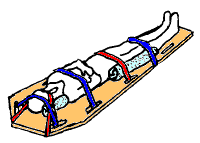Immobilization (medicine)
When immobilization is known in medicine, the immobilization of body parts for the purpose of healing from injury or to prevent injury accident victims through rescue and patient transport .
The bone healing after bone fracture takes place more quickly the less the broken ends are mutually movable. Immobilization of the transferred piece of skin is also necessary for skin transplants . Immobilization is carried out using various aids such as splints, plaster casts and other bandages.
The immobilization leads to structural changes relatively quickly and thus to a reduced load-bearing capacity of the immobilized body part. The speed of these remodeling processes is higher in injured tissue than in neighboring uninjured tissue. A immobilized, uninjured joint can stiffen after just 6 weeks. After prolonged immobilization in the connective tissue, hydrogen bridges develop between the collagen fibrils, which are now closer to one another, due to the loss of intercellular substance, and the collagen fibers are finally remodeled. In the cartilage of immobilized joints, the intercellular substance and thus the resilience also decrease due to the lower stress. On the joint capsule , reserve folds can stick together due to adhesion and cohesion and thus restrict movement of the joint. There are also adhesions between the capsule and bones or between muscles and bones, as well as muscle fibrosis and shortening of muscles and ligaments.
Individual evidence
- ↑ Frans van den Berg: Applied Physiology. Part 1: Understanding and influencing the connective tissue of the musculoskeletal system. 2nd Edition. Georg Thieme Verlag, 2003, ISBN 3-13-116032-2 , p. 283.
- ↑ Frans van den Berg: Applied Physiology. Part 5: Understanding and integrating complementary therapies . Georg Thieme Verlag, 2005, ISBN 3-13-131121-5 , p. 447.
- ^ Frans van den Berg: Applied Physiology , Georg Thieme Verlag, 2003, ISBN 978-3-13-116032-4 . P. 139 .
